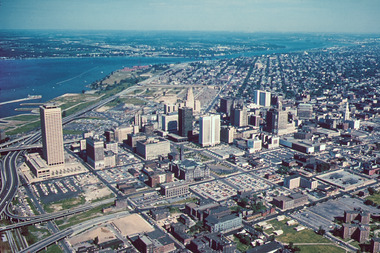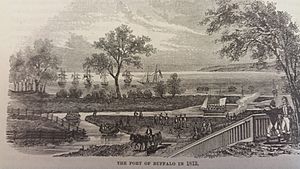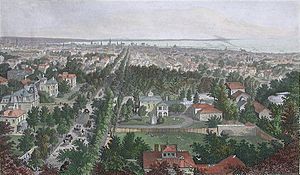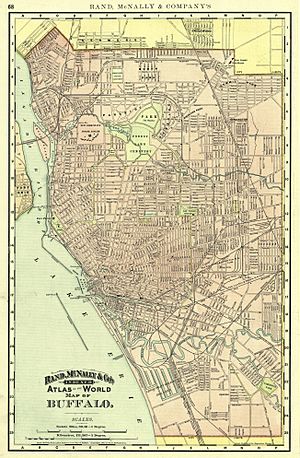History of Buffalo, New York facts for kids
Buffalo is a big city in New York state. It's the second largest city in New York, right after New York City. Buffalo started as a small trading village around 1789. It was near a creek called Buffalo Creek. The city grew very fast after the Erie Canal opened in 1825. Buffalo was at the western end of this important canal. Its location on Lake Erie helped its economy. The city became known for milling grain and making steel.
In the early 1900s, Buffalo was one of the biggest cities in the United States. It hosted a huge event called the Pan-American Exposition in 1901. Later, it became a key place for making cars.
Over time, things changed. The opening of the Saint Lawrence Seaway and people moving to the suburbs caused Buffalo's main industries to slow down. The city's population dropped by more than half from 1950 to 2010. But Buffalo is still an important city. It now has a mix of industries, including advanced manufacturing, healthcare, and education.
Contents
Why is it Called Buffalo?
The city of Buffalo got its name from the creek that flows through it, Buffalo Creek. But no one is completely sure how the creek got its name!
One idea is that early French explorers saw many buffalo near Lake Erie. However, it's not clear if these animals were ever on the banks of Buffalo Creek itself. Native American names for the creek, like Teyohoseroron (Place of the Basswoods), and French names, like Riviere aux Chevaux (River of Horses), didn't stick. So, the name probably came from the British after they took over in 1759.
Another idea is that a Seneca Native American lived there. His name might have meant "buffalo," or he might have looked like a buffalo. English settlers might have translated his name to "Buffalo," and the creek where he lived became "Buffalo's Creek." But there's no record of a Native American named Buffalo.
Some historians once thought that an interpreter might have mixed up the Native American word for "beaver" with "buffalo" during a treaty signing in 1784. The words are very similar. Since there were beavers in the area, they thought it might have been called Beaver Creek.
A newer idea from 1909 suggests the name came from the French words Beau Fleuve, meaning "beautiful river." This was supposedly said by an explorer named Louis Hennepin when he saw the Niagara River. But old records don't show him saying this.
More recent information shows that the name Buffalo Creek was commonly used by 1764. It might have been named by an English speaker who saw animal bones, perhaps from bison, elk, moose, or even farm animals, near a salt lick by the creek.
Early History of Buffalo
Native American Life
Native American groups, sometimes called First Nations, used the Great Lakes and rivers as their main travel routes. They often traveled to visit other tribes and trade goods. Buffalo, located near the Niagara River, was a popular spot for these traveling tribes.
Before Europeans arrived, the Wenro people lived in this area. They were an Iroquoian-speaking tribe. They lived along the south shore of Lake Ontario and the east end of Lake Erie. The Wenro were a smaller group, possibly related to the Neutral Nation or the Erie people.
The French explorers found the Neutral groups helpful in settling arguments with other tribes. The League of the Iroquois became enemies of the French early on. Around 1651, the Iroquois Confederacy went to war with the Neutrals. By 1653, the Iroquois, especially the Senecas, had almost completely defeated the Neutrals and the Wenro. The Seneca tribe then moved into the Wenro's land.
First European Settlers
Charles II of England gave most of western New York to the Duke of York. But the first European settlement in what is now Erie County was by the French in 1758. It was at the mouth of Buffalo Creek. The French destroyed their buildings a year later when the British captured Fort Niagara. The British took control of the whole region in 1763 after the French and Indian War.
The first people to settle permanently in Buffalo were Cornelius Winney and "Black Joe" Hodges in 1789. They opened a log cabin store to trade with Native Americans. The British kept control of the area until 1796.
Dutch investors bought the land from the Seneca Indians. This was part of the Holland Purchase. A famous Seneca leader named Red Jacket was involved in selling this land. He died in Buffalo in 1830 and is buried in Forest Lawn Cemetery.
Starting in 1801, land was sold through the Holland Land Company. The settlement was first called Lake Erie, then Buffalo Creek, and soon just Buffalo. The Holland Land Company agent, Joseph Ellicott, tried to name it New Amsterdam, but that name didn't stick. In 1808, Buffalo became the county seat of Niagara County. Later, in 1821, Erie County was created from Niagara County, and Buffalo remained its county seat.
The 19th Century
In 1804, Joseph Ellicott designed Buffalo's streets. They spread out from downtown like bicycle spokes. This is a very unique street pattern in the U.S. In 1810, the Town of Buffalo was formed.
During the War of 1812, on December 30, 1813, British troops and their Native American allies captured and burned most of Buffalo. But Buffalo slowly rebuilt itself. By 1816, it had a new courthouse.
When the Erie Canal was finished in 1825, Buffalo became the western end of this 524-mile waterway. The canal connected Buffalo to New York City. At that time, Buffalo had about 2,400 people. With the canal bringing more trade, the population grew very fast. Buffalo officially became a city in 1832.
In 1843, the world's first steam-powered grain elevator was used in Buffalo. It was built by Joseph Dart, Jr., and Robert Dunbar. This "Dart Elevator" helped Buffalo become a major center for grain. Many more grain elevators were built in Buffalo's harbor.
In 1853, Buffalo took over Black Rock, a nearby village that had been its rival for the canal's end point. In the 1800s, thousands of pioneers traveling west passed through Buffalo. They would leave canal boats and continue their journey by lake or train. Many visited Buffalo's busy Canal district.
Buffalo was also an important stop on the Underground Railroad. This was a secret network of safe places for African-Americans escaping slavery. People in Buffalo helped many fugitives cross the Niagara River into Canada to find freedom.
U.S. Presidents and Buffalo
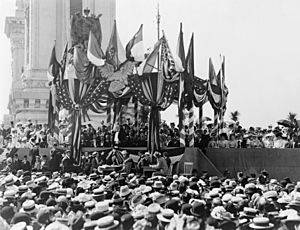
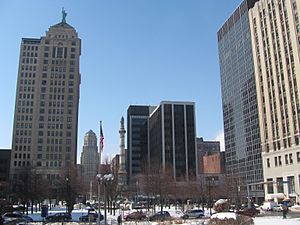
Several U.S. presidents have connections to Buffalo:
- Millard Fillmore lived in Buffalo starting in 1822, before he became the 13th president. He was also the first leader of the University at Buffalo.
- Grover Cleveland, who was the 22nd and 24th President, lived in Buffalo from 1854 to 1882. He was even Buffalo's mayor from 1882 to 1883.
- William McKinley was shot on September 6, 1901, at the Pan-American Exposition in Buffalo. He died in Buffalo on September 14.
- Theodore Roosevelt then became president on September 14, 1901. He was sworn in at the Ansley Wilcox Mansion, which is now the Theodore Roosevelt Inaugural National Historic Site. This was one of the few times a president was sworn in outside of Washington, D.C..
The 20th Century
At the start of the 1900s, Buffalo was a growing city with a strong economy. Many immigrants came from Ireland, Italy, Germany, and Poland. They came to work in the steel and grain mills. These industries used Buffalo's great location where the Great Lakes met the Erie Canal.
Electricity from nearby Niagara Falls made Buffalo the first American city to have widespread electric lighting. This earned it the nickname, the "City of Light." Electricity was used in amazing ways at the Pan-American Exposition in 1901. This exposition was also where President William McKinley was shot.
The Peace Bridge, which connects Buffalo to Fort Erie, Ontario in Canada, opened on August 7, 1927. This was a big celebration.
The Great Depression (1929-1939) caused many people to lose their jobs. Buffalo's City Hall, a beautiful Art Deco building, was finished on July 1, 1932.
Buffalo's importance started to decline in the second half of the 20th century. One big reason was the opening of the St. Lawrence Seaway in 1957. This new waterway allowed ships to bypass Buffalo and go directly to the ocean. Also, many people moved from the city to the suburbs. The city's population dropped by about 50% as industries closed. People left the Rust Belt region to find jobs in other parts of the country.
The 21st Century
In 2003, Buffalo faced some money problems. The Buffalo Fiscal Stability Authority was created to help manage the city's finances. They had to approve or reject all big spending.
However, things started to look up for Buffalo. In 2006, new economic projects in the city were valued at $3.5 billion, which was a huge increase from previous years. Many new buildings and renovations happened, especially downtown. Buffalo even ranked high on a list of best cities for jobs, doing better than bigger cities like New York City and Detroit.
In November 2005, Byron Brown was elected Mayor of Buffalo. He was the first African-American to hold this important office.
Images for kids


